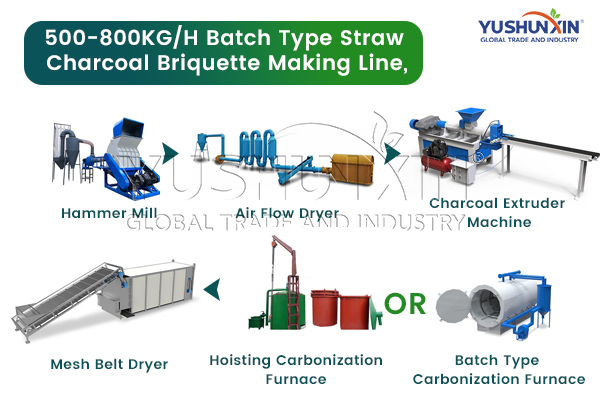Straw, a by-product of agriculture, is often seen as waste. However, in recent years, it has gained increasing attention as a renewable and profitable resource—especially for producing charcoal briquettes. Here’s why straw is one of the best choices for biochar production.

🌾 Abundant and Renewable Resource
Straw is a by-product from crops such as rice, wheat, barley, corn, and sorghum. It is available in massive quantities worldwide, especially in rural and agricultural regions. Since straw is typically discarded, burned, or left to decompose, using it for charcoal briquette production adds value to what would otherwise be agricultural waste. This not only reduces environmental pollution but also provides an affordable and sustainable raw material source.
♻️ Environmental Benefits
Utilizing straw for briquette production supports eco-friendly and carbon-negative practices. When straw is carbonized in a controlled environment (using a carbonization furnace), it avoids releasing harmful gases that occur with open burning. The resulting charcoal is cleaner-burning than traditional firewood or coal, producing less smoke and fewer pollutants. This contributes to better indoor air quality and reduces greenhouse gas emissions.
🔥 High Carbon Content and Good Combustion Properties
Straw has a relatively high cellulose and lignin content, which makes it a good candidate for carbonization. After proper drying, crushing, and carbonizing, the charcoal produced from straw has strong heating value and good combustion stability. It burns evenly, generates consistent heat, and leaves behind minimal ash—making it ideal for household heating, industrial boilers, and even BBQ applications.
💰 Cost-Effective and Profitable
Compared to wood or other biomass, straw is much cheaper—or even free. Farmers are often willing to give it away to avoid the costs of disposal. By turning straw into charcoal briquettes, you reduce raw material expenses and increase the overall profit margin. Moreover, governments and environmental organizations often support biomass recycling projects with subsidies, making the investment more attractive.
🏭 Easy to Process and Mechanize
Straw is lightweight and easy to crush into small particles. Modern straw briquette production lines—including crushers, carbonization furnaces, mixers, molding machines, and dryers—are highly automated and efficient. This simplifies the process and reduces labor intensity, making it suitable for both small-scale and industrial-scale operations.
Conclusion:
Choosing straw to make charcoal briquettes is not only environmentally friendly and cost-effective, but it also opens the door to a scalable, sustainable business opportunity. With the right equipment and process, straw can be transformed from farm waste into high-value biochar. Visiting: https://www.char-molder.com/product/straw-charcoal-briquette-plant/
Leave a Reply